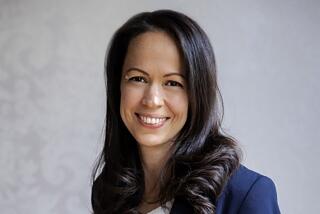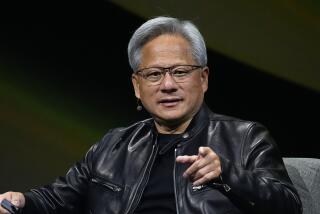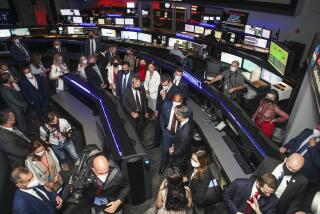Tough Love From NASA’s Top Official
- Share via
Visiting two high kingdoms of Southern California research this week, NASA chief Daniel Goldin brought his tough love show to town. And his subjects ate it up.
Brandishing a style unlike any of his predecessors, the cowboy-booted space honcho came down hard on engineers at USC and NASA’s Jet Propulsion Laboratory, saying that the work they are doing “isn’t good enough.”
Goldin took the occasion of National Engineering Week to lambaste his own kind for hanging on to a “narrow nerd mentality” in danger of producing “robots and zombies.”
“I want to get astronauts to Mars,” he said. “I don’t want to wait 30 years. We’re not moving fast enough.”
While engineers at NASA’s JPL in Pasadena and USC’s Integrated Media Systems center (funded by the National Science Foundation) tried to show off their latest virtual spacecraft and face-recognition computers, the NASA chief constantly interrupted the well-planned presentations to challenge, scold and preach about the limits about linear thinking.
“We’re on the line,” he told his hosts at USC. Vice President Al Gore demanded last week that airplane crashes had to be reduced by 80%, he reminded them. “We have an aircraft go down, or a spacecraft fail . . . and we don’t know why it goes down.”
At the same time, he worried, no one is working on the kind of next-generation computer software needed to run a complex enterprise like the planned international space station. “I get the chills just thinking about what could go wrong,” he said. “Here we are at JPL,” which he described as the “kingdom” and “the forefront” of high-tech know-how. “And they’re not doing it here. If we can’t do better than this, we’re not going to lead the 21st century.”
If Goldin’s fellow engineers were somewhat shellshocked by his frontal, frenetic approach, they have also gotten accustomed to their leader’s blunt, confrontational style. Indeed, his unsatisfactory assessment of the state of their work only seemed to inspire them.
“The time we spent with [Goldin] was one of the most invigorating intellectual adventures of my entire scientific career,” said USC’s Armand Tanguay, deputy director of the media systems center.
What’s needed most, Goldin said, are tools that can run complex space programs, and fly (and design) spacecraft and aircraft by computer. “Our toolbox is empty,” he said.
Current state-of-the-art computer processors deal with billions or trillions of operations per second--known as “gigaflops” and “teraflops,” respectively. Next-generation software will require processes working billions of times faster. (He coined a new term--the “Saganflop” after the late astronomer Carl Sagan--to describe this new unit of speed.)
” When he took the time to catch his breath, Goldin saw things that pleased him. But he always asked for more.
At JPL, the space chief watched in a standing-room-only crowd as startlingly realistic movies of the red Martian crust rolled on the screen, exposing deep gashes that geological eons had carved on its surface.
“When you can do that in 3-D,” you’ll have something, he said.
JPL scientist Carl Kukkonen informed the chief: “This is the best technology can buy today.” Goldin returned: “It’s not good enough.”
Presented with a two-year timetable for developing “thinking, self-healing” data systems, Goldin butted in: “I’d like it to be one year.”
As computer scientist Meemong Lee demonstrated a simulated trial of a detector that will someday take a close-up look at an asteroid, he interrupted again, pointing out that the environment a spacecraft encounters is not predictable.
“So how do you deal with that?” he asked. “Take me through your thought processes.” The chief admits he “frustrates people. . . . But it’s my job to push the boundaries.”
Besides, even his targets seemed to agree with him on substance. “He’s absolutely right,” said the dean of USC’s engineering school, Leonard Silverman. “Dan is a real preacher for the cause.”
At USC’s new multimedia center, Goldin heard about total-immersion virtual reality systems, smart cameras that can recognize facial expressions and new ways to configure computer chips that allow them to think more like brains.
He kept popping up out of his seat like an eager schoolboy, pointing his fingers, waving his hands and sometimes taking over the speaker’s platform.
“I’m very hard to brief,” he said.
One of his main targets was “the folly” of trying to use numerical, hard computing to model unpredictable real-world situations like turbulence or complex systems with many interacting parts. In such situations, a small variability can change everything.
Dealing with the inherent chaos of these systems will require going beyond standard silicon hardware and computer programs that use simple 1s and 0s. The time has come, he said, to take serious looks into what is called “soft computing”--including “fuzzy logic” (which leaves room for errors), genetic computing (as performed by DNA) and neural networks (computers configured like the human brain).
So his eyes lit up as USC’s Tanguay described research into cameras that do far more than replicate the eye’s retina, and instead work in concert with something analogous to the brain’s visual processing centers.
“We need thinking systems,” Goldin said.
If the space chief had his way, new spacecraft would be designed and tested almost entirely in virtual environments.
To get this kind of technology, however, schools may have to rethink how they train engineers, the chief said. “The problem is, we’re getting nerds coming out of college,” he said. Their focus on precision above all leaves no margin for error, he said. They can solve a problem to a dozen decimal places, he added, but still not understand the fundamentals of the question they’re asking.
The NASA chief also targeted other “narrow” technology: e-mail. He doesn’t like it and doesn’t use it. “It feels so cold,” he said. “It’s a one-way monologue. People don’t ask: How are you? How are your kids? . . . If you treat people like zombies and robots, that’s what you get.”






